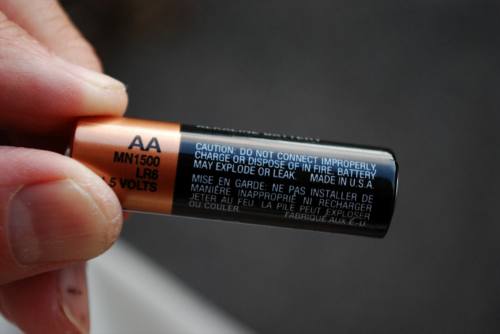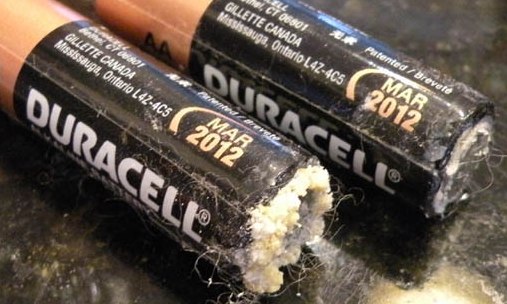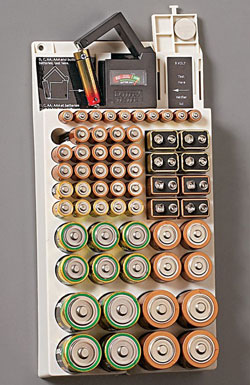 |
Bad Alkaline Battery
Charger |
A while back I bought a battery charger, which claimed to charge alkaline 1.5v
cells. I seem to use a lot of 1.5v batteries. I have many flashlights,
computer mice and MP3 players which only work with standard 1.5v alkaline cells.
The markings on almost any alkaline battery say that you should not attempt to
charge their devices. They warn that doing so could cause the battery to
leak or even explode. Still, many people claim to have some success in
putting some energy back into these otherwise disposable batteries. The
purchased charging device claimed to have the “intelligence” to properly charge
batteries. So, I thought I would test the thing. |
|
 |
 |
Alkaline/NiCd/NiMH
Battery Charger |
Battery Warning |
|
| I chose some fairly freshly
used AA cells. I usually dispose of standard alkaline batteries when their open
voltage measured 1.35v or less. I picked 4 units which measured 1.30v.
|
| The charger manual said
that the unit’s microprocessor will automatically detect the battery type and charge
the battery accordingly. I popped the 4 AA cells into the charger. The
manual said that the charge indicator LED for each battery would turn red when
charging and would later turn green when the cell was done charging. I noted
that in 2 of the 4 cells, there was a LED color change from green to red, but after
only a few seconds, those two LEDs changed back to green. The other two
indicator lights for the batteries being charged showed no color change at all and
stayed green. After a few seconds, all 4 cells showed a solid green LED indication.
So, what does that mean? Surely the cells were not fully charged in only a few
seconds. I decided to leave the batteries connected to the charger overnight.
|
| After about 8 hours, I went
back to the charger. All four charge bays still showed a sold green light. Two
of the 4 cells showed signs of leaking electrolyte. The other two looked OK. I
guess the battery manufacturers were right. You can’t charge these batteries, at
least not at the charging current rate this charger was using. All four cells
measured an open voltage of 1.6v when taken off the charger but gradually dropped to
about 1.5v in a few hours. A quick test with a 15 ohm 100ma load resistor showed that
the cells did indeed take a charge, since they were able to source about 100ma of
current. Although the two leaking cells were able to source 100ma of current, I
tossed them into the trash. I don’t want to put a leaking battery into any
device. Some research on the Internet indicated that other people had similar
problems with alkaline chargers. In some cases, the batteries did not start
leaking until days after they were taken off the charger. I think this charger
was putting too much current into the batteries. The charging current caused gas
pressure to build inside, pushing out the electrolyte fluid. I think the current needs
to be much lower. Perhaps some kind of selector switch would be needed to tell
the machine the size of the battery being charged. As an example, a big D cell
should be charged at a higher current than a much smaller AAA cell. |
| I measured the charging
current at each bay using a multimeter. I measured 55 milliamps into a 1.5v
battery. The open voltage at each charge bay measured 8.5 volts. Could the
charger be using nothing but a series resistor to limit the current? Perhaps.
It sure does not seem to be an “intelligent” charger. I might take the thing
apart later and see what more I can find out about the charger. For now, I think
I will not be using the thing unless I can carefully monitor the charging process. |
| A good alkaline AA cell
should have an Amp-hour capacity of about 2 Amp-hours or 2000 milliamp-hours. If
you were to charge a cell at say 83ma for 24 hours, you would pump 2 Amp-hours into
the cell. In theory, that should be enough to bring the battery back to life.
But, the charging process is not 100% efficient. There are losses, so if the
goal was to put 100% of the original energy back into the cell in an 8 hour period,
either the current would have to be increased or the charge time would have to be
increased. But, charging these cells at this kind of current is way too high. I think
a slower charge rate would be better for the cell, giving it time to reverse the
chemical reaction, which produces the electricity. Even a three day 72 hour charge
time would be OK by me. Perhaps the charger circuit could monitor the cell
voltage increase and tapper the charge current as the voltage increased. Maybe
after three days of charging, the charger would lower the charge current to perhaps
C/200 or just 10ma for an AA cell. A big D cell might be able to handle 50ma of
final charge current while a small AAA cell might terminate the charge cycle with just
5ma of current. I think the ideal charger would charge perhaps 4 cells at time over a
4 day period. Once completed, the cells would then go into a storage rack, like
the one shown below. Alkaline cells have an excellent long term storage
characteristic. They should last many years once charged. Maybe each
battery would be thrown away after two or three recharge cycles. |
 |
 |
|
Leaking AA Battery Cell |
Leaking AA Battery Cell |
 |
|
Battery Storage Rack with Voltage Tester |
|
|